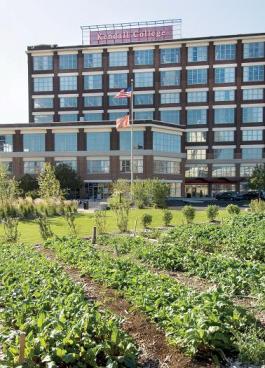Green Tomato: Organic, Biodynamic, Local ... Oh, My!
06 September 2010By Christopher Koetke, CEC, CCE
 Defining “sustainable food” is not a black-and-white issue like water and energy conservation or waste-stream reduction. The decisions are value judgments that are unique to each individual.
Defining “sustainable food” is not a black-and-white issue like water and energy conservation or waste-stream reduction. The decisions are value judgments that are unique to each individual.
What is sustainably farmed food? Is it organic? Is it biodynamic? Is it local? Dr. Fred Kirschenmann, sustainable-agriculture pioneer and distinguished fellow with The Leopold Center for Sustainable Agriculture, says the answer to those questions is, “Sometimes, but not necessarily.” Recently, I had the opportunity to chat with him about this subject and came away with a new understanding of the complexities.
Organic
Kirschenmann served on the USDA National Organics Standards Board, which developed the rules for implementing the National Organic Program. According to those standards, organic means that producers can use any natural inputs as long as they aren’t on the “prohibited list” (e.g., elemental sulfur or copper as a plant or soil micronutrient). The only synthetic inputs allowed are those on the “allowed list” (e.g., certain chlorine materials related to food-safety concerns).
Sustainable? Maybe. Organic certification does not address protecting the biological health of the soil, which is critical for long-term sustainability, nor does it consider the source of the natural inputs. If, for example, a farmer sources seaweed from Japan or Chilean nitrate from South America, that could have quite a dilatory effect on his carbon footprint, another important aspect of sustainability.
Biodynamic
Originally defined by Rudolf Steiner in the 1920s, this method of agriculture viewed the farm as a living organism and, thus, it had to be self-contained. Everything used on the farm needed to be part of the farm—nothing was brought in from outside. Today, that’s not strictly adhered to, so for practical purposes, biodynamic is similar to organic except there’s a strong emphasis on maintaining the biological health of the soil.
Sustainable? Maybe. According to Kirschenmann, “There’s the notion of what I call ‘steady state sustainability,’ which assumes the context in which the way everything functions will stay the same and then all we have to do is ‘green it up,’ make it more environmentally friendly, and then we’ll be sustainable.” Biodynamic adds to organic by addressing soil health, but it does not address resilience. In other words, when disturbances in a system inevitably occur, there needs to be sufficient redundancy to bring the system back to normal. Kirschenmann goes on to say, “The more I’ve thought about it, I think that [resilience] gets at the heart of what sustainability needs to be, particularly as we anticipate a future with the end of cheap energy, more unstable climates, and depleted water resources.”
Local
With local, there are even more variables, starting with, “How local IS local?” There are differences of opinion on how far a product can travel and still be considered local, ranging from 50 to 150 miles. One of the greatest advantages of buying local foods is that it’s much more likely to be fresh, which enhances its taste and health attributes. It also supports the sustainability of the local economy. However, there are some very practical problems that arise with this constricted view. For example, looking at the New York City metro area with about 30 million people, there’s no possible way to feed them with food produced within a 150-mile radius. Conversely, in a farming region with a much smaller population, much of its farmland would lie fallow if food didn’t travel beyond that 50-150 mile radius.
And is it sustainable? Again, the answer is maybe. Eating local presumes a reduction in the eco-footprint on the food produced. Data indicates that may not always be true. If a farmer puts a few crates of vegetables in the back of a pick-up and sells them at a number of farmers’ markets located within a 150-mile radius, his carbon footprint could very likely be larger than an 18-wheeler that hauls a full truckload of produce in from California. If that produce were shipped by train, the eco-footprint would be even smaller. As Kirschenmann says, “Our industrial food system has been quite good at reducing transaction costs and that includes both economic and environmental costs.”
So what’s the answer? Unfortunately, it’s not black and white like water and energy conservation or waste-stream reduction. The decisions are value judgments that are unique to the individual. Why not pose the question to your students? Let them do the research and debate the issues. It will be a rich learning experience that will also exercise critical-thinking skills.
Christopher Koetke, CEC, CCE, is dean of Kendall College’s School of Culinary Arts and vice president of Laureate International Universities Center of Excellence in Culinary Arts. Kendall College sponsors the annual CAFÉ/Kendall annual Green Award.
Additional Info
- CAFÉ Talks Podcast Lesson Plan: 1



